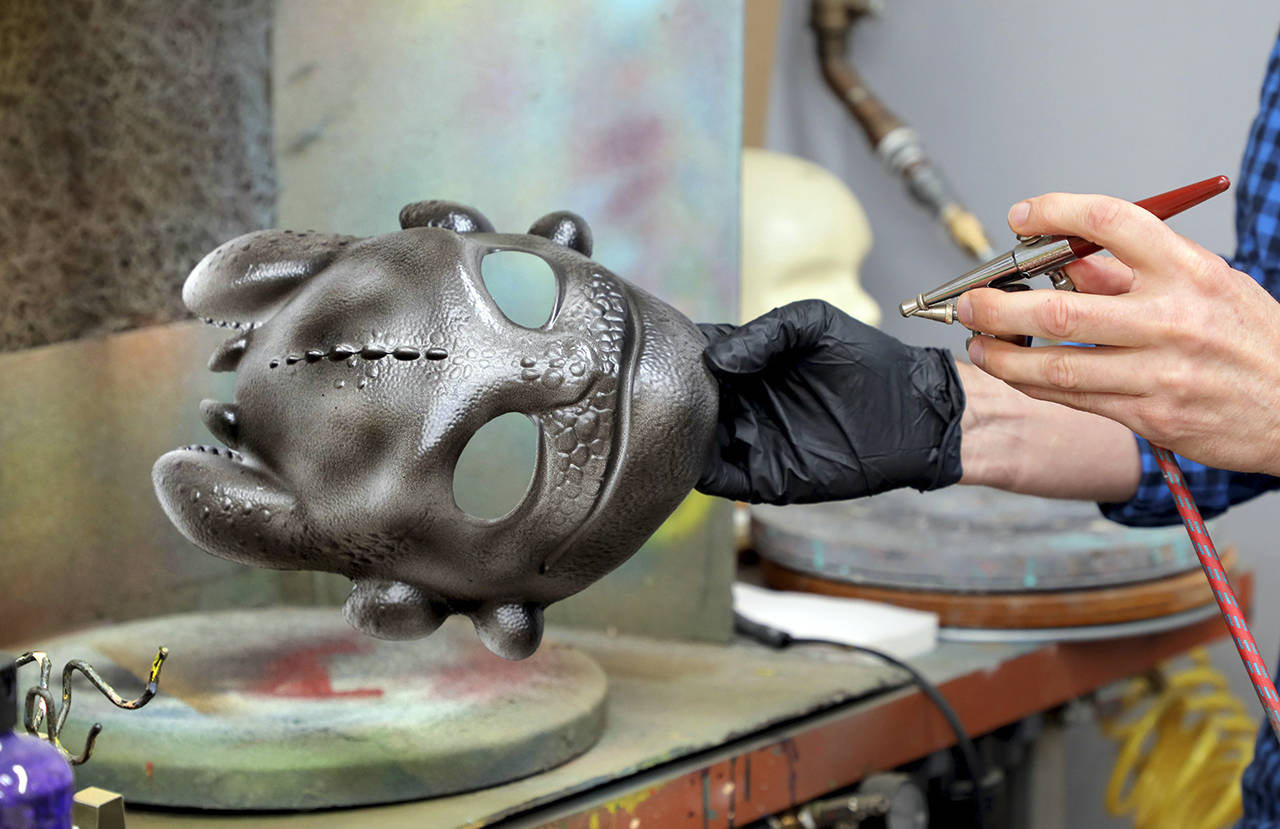POWAY, Calif. — A nondescript tan and white industrial park building in Poway is where Halloween revelers are transformed into an Incredible, a Disney princess, Mario or Donald Trump.
But it is not a local dressing room or seasonal pop-up costume shop.
It’s the headquarters of Disguise, a secretive company where about 65 cosplayers, technicians, computer wizards and assorted “creatives” take TV, movie and video game characters and turn them into Halloween outfits for toddlers, millennials and baby boomers.
You can’t shop at Disguise, but if you’re in the retail business or lucky enough to get inside, you’ll see what’s been hot this year and what might be trendy next Halloween.
Disguise is not a seasonal business. “It’s Halloween all year ’round,” said Pauline Cuevas, a member of the graphics department.
It’s been only in the last couple of decades that costume retailing has graduated from being a largely mom-and-pop business to one dominated by a few manufacturers, such as Disguise, which says it has 25 to 30 percent of the market. (Rubie’s Costume in Melville, New York, is the nation’s biggest customer manufacturer.)
The companies take their cues from pop culture and compete for licenses from big movie, TV, video game and toy companies. The day of the do-it-yourself costume is giving way to time-challenged households where kids want to look like a Ninja Turtle or Zelda, princess of Hyrule. The generic ghost, witch and zombie just won’t do.
Costumes designed by Disguise end up in big-box retailers like Target, Walmart and Party City, and in pop-up Halloween stores.
The day of ghosts and superheroes isn’t just a penny-candy day. At $9 billion, it’s the third biggest holiday of the year after Christmas and Thanksgiving.
Disguise President Joe Anton has been with the 31-year-old company almost from the beginning, starting as a sales rep in Dallas, when the internet was science fiction and the Sears catalog had not been overtaken by Amazon.
“More than anything else, I get satisfaction out of seeing our product on shelf at retail and standing there listening to kids getting excited when they see our products,” Anton said.
Jakks Pacific, a toy company founded by Jack Friedman in 1995 and based in Santa Monica, bought Disguise in 2008 to expand its children-focused product line. But Halloween’s popularity now appeals to everyone, not just youngsters.
A projected 175 million Americans are expected to celebrate this year – and 31 million of their pets will also be dressed up, as well (most popular costume: pumpkin). “There was a time I remember when my kids were little, I always dressed up,” said Jakks CEO Stephen Berman.
Most of Disguise’s Halloween costumes are priced low enough (starting at about $20) to be worn just once or twice.
The process starts with Disney, Nintendo, Lego and other companies announcing future releases. Disguise then translates items on the screen into real-life props to wear (complete with built-in six-packs for Mr. Incredible).
They take original artwork from the companies and use computers, 3-D printers, sublimation machines and old-fashion scissors, thread and fabric to mock up the final product.
Last week Jacqueline Soto was finalizing a design for Shego, a character in Disney’s “Kim Possible” TV show.
But like many colleagues, Soto doesn’t leave her imagination at work. She’s a veteran cosplayer who won an award at this year’s San Diego Comic-Con for her portrayal of Mercy in the “Overwatch” video game.
Dane Munkholm was sculpting a mask using “digital” clay on his computer screen.
“It’s definitely more tactile” when using real clay, he said, but it’s faster and more accurate to poke and stretch the image on a screen.
Munkholm and many of the other 65 Disguise staffers were still pondering what to wear at the company’s noontime costume contest on Halloween Day.
The 25,000-square-foot warehouse on Kear Place is large enough to store cartons of sample costumes, buttons, ribbons and other craft materials, and to show off masks of monsters and superheroes from Halloweens gone by.
David Lea showed off a Vacuform machine that molds a plastic sheet around a resin helmet. He then opened a nearby door of a room set aside just for the company’s single 3-D printer. It was a quarter of the way along in a 5-hour project to produce a set of small bat wings.
“It was all clay and hand-sculpted” when he joined the company in 2004, Lea said.
But it’s not all high-tech in the sample room, where seamstresses stitch costume prototypes on sewing machines. Each day at 1 p.m., models arrive for fitting time to see how the costumes look on people.
Graphics designers formulate the packaging to the specifications of the retailers – 200,000 copies of Little Outrageous Little’s Diva costume may be manufactured in one year but packaged in five or six different retailer configurations, said designer Sean Hemak.
The costumes are vetted internally before they’re sent to the licensor for approval. Then it’s on to the Meisheng Cultural & Creative factory in Hangzhou, China, where the digitally transmitted designs and instructions guide the 120-day manufacturing and shipping process.
The costumes have to be ready to hit the shelves by summer. They’re warehoused in the City of Industry in Los Angeles County.
Anton said it’s tricky to anticipate the big seller from one year to the next.
There were high hopes when “Fantastic 4” was announced in 2014, but after it bombed at theaters in 2015, it was too late to cancel the costume orders.
On the other hand, “Frozen” was a sleeper. Before it debuted in November 2013, Disguise only had 2,500 costumes in stock of Anna and Elsa. For Halloween 2014, the company produced hundreds of thousands.
“And it hasn’t stopped,” he said.
The sequel is tentatively scheduled to hit the screen Nov. 27, 2019. But Disguise is also finalizing costumes tied to “Lego Movie 2: The Second Part,” “Toy Story 4,” “How to Train Your Dragon: The Hidden World” and a live-action “Aladdin.”


